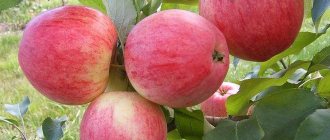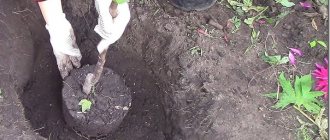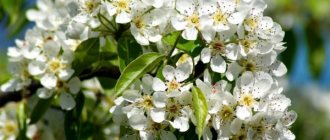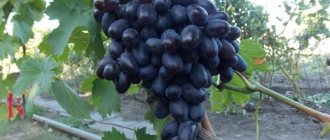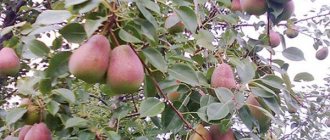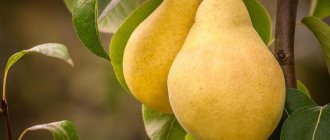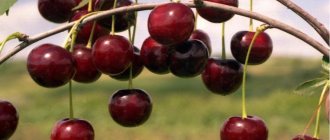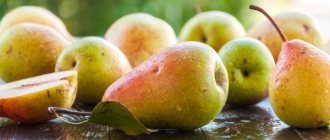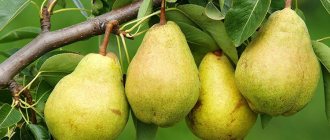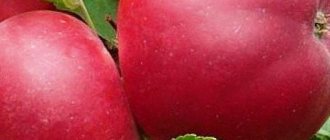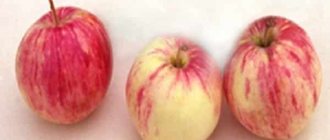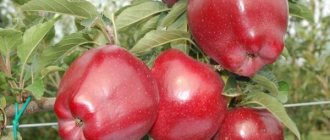Permyachka pear.
Description of the variety
The Permyachka variety is summer, one of the early. An amazing property of the pear is its high adaptability to various weather conditions and its sudden changes.
Characteristics of wood
The tree grows very quickly, they are of medium height, up to 5 meters maximum. The trunk is thick, covered with grayish bark. The branches are numerous, creating a spreading crown of a large number of small shoots with large leaves.
Description of fruits
Permyachka.
Fruits of medium and above medium size, up to 200 grams in weight, bell-shaped. The skin is green, turning yellow as it ripens.
The pulp is very juicy, sweet and meaty. The taste is very uniform, without aftertaste or acidity. Tasting scale rating: 5 points.
Secrets of successfully growing Permyachka pears
The Permyachka pear variety belongs to the summer category. Bred by breeder L. A. Kotov as a result of hybridization of the “Tyoma” variety and a form based on the “Elena” and “Cosmic” varieties.
Description and characteristics
The Permyachka pear forms a fairly tall plant, which is characterized by a rapid growth rate. The tree has a wide pyramidal or almost rounded crown. The fruits are large. The average weight of a ripened pear varies from 140 to 160 g, and with proper care, the weight of the fruit reaches 260-280 g.
The surface of the fruit is lumpy, with pronounced ribbing. The shape is closer to pear-shaped or cone-shaped. The main coloration is light yellow, and the top coloration is expressed in a slight orange blush. The pulp is white, with a distinct fine-grained consistency, quite juicy and tender.
There is almost no acidity in the taste.
The period of removable fruit ripeness occurs in the last ten days of August or the beginning of September and may vary slightly depending on weather conditions in the growing region. The description of the Permyachka pear variety states the need for planting close to the pollinator, namely pear trees of the Severyanka variety.
Planting methods
It is recommended to plant Permyachka pears with two-year-old, well-developed seedlings, which can be planted on a prepared site not only in spring, but also in autumn.
Autumn planting takes place in the first half of October, and spring planting should be carried out in the last ten days of April. More often, gardeners practice spring planting of garden plantings.
For spring planting, the holes need to be prepared before the first frost, around October or November.
The optimal area for growing pears is an area with sandy and loamy soils. The soil should be neutral or slightly acidic. Lowland areas where cold air masses stagnate are unsuitable for cultivating pears.
How to plant a pear (video)
The entire area allocated for planting fruit seedlings should be dug up deeply, and organic and mineral fertilizers must also be applied. Landing is carried out in accordance with the following rules:
- the standard size of the planting pit, depending on the volume of the root system, can vary from 60 to 80 cm;
- the depth of the planting pit on heavy and clayey soils should be at least 0.9-1 m, and on fertile and peaty soils it is sufficient to maintain a depth of 70–80 cm;
- a mixture consisting of a couple of buckets of humus, a couple of buckets of sand, a glass of superphosphate, a couple of spoons of potassium sulfate and garden soil should be poured into the hole;
- before planting the seedling, a wooden support should be installed in the southern part of the hole, to which the young plant is initially attached for vertical direction of growth;
- the root system in the planting hole should be carefully straightened, and the seedling itself should not be too deep into the ground.
Apple tree variety "Lobo": description of the variety and reviews from gardeners
After planting, the seedlings should be watered at the rate of a couple of buckets for each plant. For watering in the tree trunk circle, it is recommended to make a special hole with a diameter of no more than 20-25 cm. It is advisable to mulch with peat after watering. The standard layer of mulch is no more than 8-10 cm.
Feeding rules
To properly fertilize, you should take into account the area of the pear tree trunk, which increases every year. For plants under 4 years of age, the feeding area is 5 square meters. m. For plants aged 6–8 years, the volume of fertilizers is calculated based on a feeding area of 10 square meters. m. A fruit tree over 8 years old needs 20 square meters. m. food area.
For full development and increased productivity, the Permyachka pear should be fed systematically:
- spring feeding is carried out with peat, compost, manure and humus, which enrich the soil with nutrients and have a beneficial effect on the condition of the soil;
- You can prepare the fertilizer yourself, taking into account that the optimal ratio of nitrogen, phosphorus and potassium is 3: 1: 4;
- from organics, slurry and mullein are excellent for pear trees, which can be used without preliminary fermentation, but must be diluted with settled water in a ratio of 1: 5;
- Fertilizing with phosphate fertilizers in the form of phosphate rock or superphosphate, as well as potassium fertilizing with potassium sulfate, are effective.
It is very important to remember that timely feeding of pears after flowering is a necessary measure that helps improve the quality of the fruit.
Reviews from summer residents
Gardeners speak quite positively about the Permyachka variety and characterize it as having good productivity and early fruiting. The plant begins to bear fruit from the third or fourth year of life.
Pear "Svarog": characteristics of the variety and methods of protection against the codling moth
How to trim a pear (video)
Average yields under favorable soil and climatic conditions are about 30-32 kg per mature tree. In general, this variety, according to summer residents, performs well in home gardening and has sufficient winter hardiness to allow it to be grown in central Russia.
Did you find an error in the text? Please select it and press Ctrl+Enter. Thank you!
:
Source: https://gryadochkin.ru/sekrety-uspeshnogo-vyrashhivaniya-grushi-permyachka.html
Reviews
Pauline
Astrakhan
These are my favorite pears, they are so sweet, you will lick your fingers. I make jam, jam and compote from them. And Permyachka itself is unpretentious and can be grown without problems.
Igor
Zemlyagorsk
I have different pears on my plot. Permyachka is already 14 years old. She's great, I like that she doesn't get sick. I only prune twice a year because the tree grows so profusely.
Faina Mikhailovna
Svetlodar
The sweetest pears I have ever tried were from Permyachka. I make jam and preserves. Children and grandchildren love candied fruits and pear marmalade.
Video “Prevention and treatment of pear”
From this video you will learn about methods of preventing and treating pear trees from various diseases.
Among gardeners, this species is considered rich in harvest, because you can get several times more fruit than from an apple tree or other tree. It also happens that branches simply cannot withstand such a load and break. Therefore, during the fruit harvest period, reinforcements for the crown and branches of the pear are often used.
Standards
All Permyachka fruits are quite large in size, because the average weight is about 150 g, and under good growing conditions it can reach 200 g. They resemble a bell in shape, with a rough, ribbed surface. If we talk about the color of this pear variety, then it is light yellow or green. According to the description of the owners, a pleasant pink blush can occasionally be seen.
The pulp of this variety is distinguished by its light shade, tenderness, absence of grains and enveloping effect. There is no sourness here at all. Any gardener or specialist would rate this pear five out of five. Harvesting occurs at the end of August and the first days of September. And for about two more weeks the pearl will be fresh and tasty.
If we talk about pollination, then Severyanka is considered the best for this variety of pears. In addition, it is worth paying attention to the high fruiting, which lasts for about four years for one tree. Thus, every year you can get at least 30 kg of fruits of this variety. Based on reviews from gardeners, the tree tolerates frost well, but not in northern countries, where this indicator is at an average level.
Landing
The Permyachka variety easily adapts to different conditions and is able to bear fruit well on infertile soil. It is grown even in harsh regions. To familiarize yourself with recommendations for choosing a site and preparing a planting hole, you must follow the links below.
How to plant a pear tree correctly
At what distance to plant pears?
How to choose pear seedlings
How to replant a pear
Selection of seedlings
When choosing seedlings, you should pay attention to the age of the young. For planting, it is best to choose trees that are no more than one year old. Plants at the age of two have a fairly impressive and strong root system, so such a bush will take much longer and more painfully to take root.
An important factor when choosing a pear tree seedling is the grafting site. It should be located 10-15 cm from the root collar. If the tree has been grafted according to all the rules, then its trunk will have a slight curvature.
Garden hibiscus - propagation, care: Possible problems in growing
When purchasing a tree, you need to carefully examine it and peel off the bark a little with your fingernail. If the color of the wood is bright green, it means the bush is quite healthy and ready for replanting. Also, a mandatory condition for purchasing a seedling is a healthy root system without signs of putrefactive diseases and mechanical damage. You need to remember that it is best to purchase bare seedlings (leaves should be completely absent).
Care
Caring for the Permyachka pear plays an important role for the further development of the plant, especially in the first years after planting. In the articles selected below, you can familiarize yourself with useful materials on agricultural technology.
How to care for a pear Pruning a pear Pruning a columnar pear Treating a pear from diseases and pests Feeding a pear How to water a pear
Top dressing
Before carrying out work on feeding the plant, it is necessary to find out what the “nutrition area” is. This is a term used by agricultural technicians. The feeding area is a conventionally designated circular area around the tree trunk, corresponding to the crown. At different periods of life, a variety of fertilizers should be applied to a given area.
For example, the feeding area for young residents of the garden is about five square meters. This means that the treated circle around the plant should have a diameter of 1.25 meters. Pear trees are treated with water fertilizers, which means that any necessary fertilizer is diluted in water and applied evenly over the entire area of the designated circle.
Important! It is necessary to remember that the diameter of the circle of the “nutrition area” of an adult Permyachk pear tree reaches 1.95 meters.
Diseases and pests
Trees of this variety are highly resistant to scab and powdery mildew. To protect the plant from other diseases and harmful insects, preventive spraying should be carried out regularly. You can read more about prevention using the links below.
Dangerous Pear Pests
Pears often suffer from pests, they affect the leaves, bark and fruits.
In this article, we have selected 11 of the most harmful insects that harm pear trees, and also ways to destroy them.
Diseases of pear trees
To get what they cherish, gardeners have to work hard, and the reason for this is pear diseases.
Read about 19 common pear diseases and how to combat them.
Advantages and disadvantages of the variety
The main parameters mentioned in the descriptions of varieties of different plants are fertilizers, soil, watering and temperature conditions. Thus, the described pear variety is moisture-loving and requires timely and abundant watering. Tolerates winter frosts well. But in order to avoid partial or complete freezing in too cold winters, the trunk and crown of the pear must be covered with film or agril.
Among the positive qualities are:
- high fertility;
- low maintenance requirements;
- good taste of the fruit (especially considering that this is a winter-hardy hybrid).
The main disadvantages of this variety are the rather impressive size of the trees, which makes harvesting quite problematic. And also self-sterility, that is, without a companion the plant will not bear fruit. Since the Permyachka pear is a plant that loves moisture, it is susceptible to various diseases. Therefore, it is necessary to regularly sanitize it with urea.
In general, this pear variety is excellent for cultivation in the Urals and Siberia. The pear will be appreciated in the Sverdlovsk, Perm and Tyumen regions.
Choosing a location on the site
To plant the Permyachka pear, you need to choose a sunny place. The south-eastern or eastern part of the site is best suited. Particular attention should be paid to the groundwater level: it should be no closer than 3 m to the surface. Dense clay soils are not suitable for planting planting material, and if this type of soil predominates in your area, then it needs to be replaced by layer-by-layer removal.
It should also be noted that it is better not to plant the Permyachka pear next to rowan. The fact is that these plants are affected by the same pests and diseases, so there is no need to make their task easier. The plant reacts normally to soil acidity (choose soils with an average pH level).
